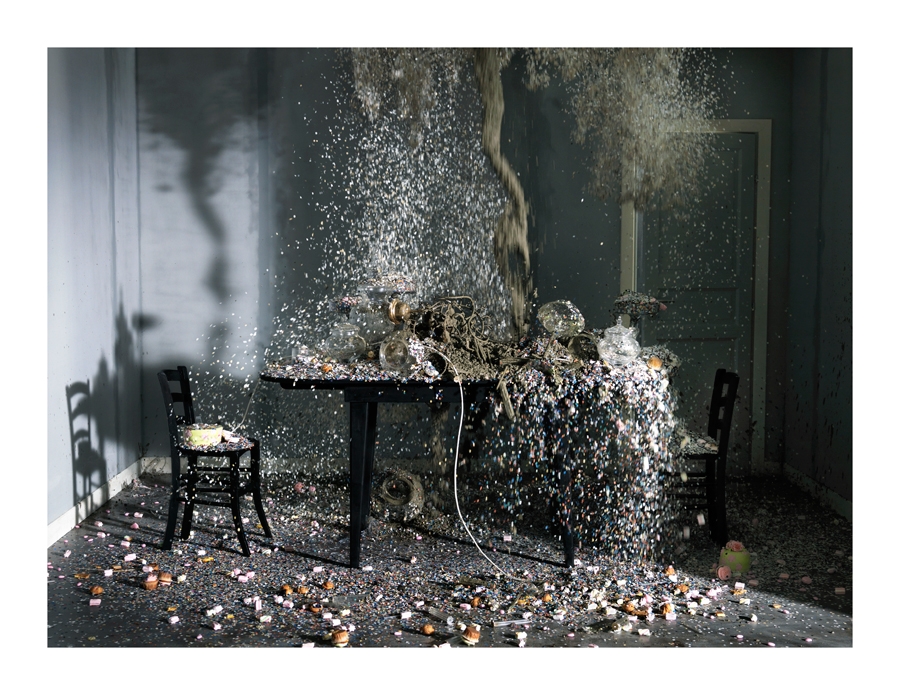In Michel Houellebecq’s novel Atomised (1998), the French novelist presents a kind of nihilistic image of the human species as a pathetic scourge that will shortly drive itself to its own extinction due to the advance of genetic cloning. The book’s end features an epitaph to humanity: ‘we think it just to render this last tribute to humanity, a homage which itself will one day disappear, buried beneath the sands of time. It is necessary that this tribute be made, if only once. This book is dedicated to mankind.’ Although being by all accounts a misanthrope, even Houellebecq cannot resist expressing a sense of nostalgia for the blighted human project via his premature eulogy.
Indeed, in the moment that a nihilistic statement is uttered – for example, ‘there is no inherent purpose to existence’, or, simply, ‘we don’t exist’ – a contrary statement is immediately bought to the fore. Put simply, a hypothesised lack of purpose to existence presupposes the possibility of a purpose. For this reason, some of the bleakest philosophers are – wittingly or not – the most life-affirmative. Among them is Ray Brassier, who in 2007 published Nihil Unbound: Enlightenment and Extinction, a book that questions the very basis of human existence on several counts. For Brassier, the chemical composition of thought itself and the fact that scientists can trace both the beginning and the impending end of the universe (‘roughly one trillion, trillion, trillion years from now’) – thus sandwiching human life between two endless voids and thereby making it redundant – are just two facts supporting the nihilist hypothesis. Though this lends itself to a resounding rhetorical question: if we don’t exist, how do we account for the clearly visible changing forms and sensory impressions that make up our perceived reality? However, this can be simply countered with the following argument: the impressions and feelings which make up ‘reality’ are merely complex chemical interactions within one essentially purposeless object (the human object) positioned among endless others (including cars, scooters, trees, china dolls, pebbles, wheelchairs, chocolates, Santa Claus and tumbleweed). How, given this, does one ultimately extricate oneself from the void of nonexistence?
How do we account for the clearly visible changing forms and sensory impressions that make up our perceived reality?
The exhibition Todestriebe (Deathwish), dedicated to the works of the Italian artist-film-maker duo Masbedo (Nicolò Massazza and Iacopo Bedogni) at the Fondazione Merz, Turin, presents a response to such a question. Of the nine videoworks on display, two arguably point to the inherent contradictions that restore the living, existing human subject to the heart of a null existence. Ionesco Suite (2013) is a 17-minute video shot in Iceland in an interior room of an isolated house. The work features a table filled with sumptuous glass vases and containers, onto which fall confetti and marshmallows, evoking a light, if not saccharine mood. This continues until, in the last minutes of the film, a thick grey-brown concrete sludge is poured onto the table, smashing the glassware and obliterating any trace of the buildup of confetti and marsh-mallow. As the concrete begins to cover the floor, a distinct shift in mood is created as an apparent violence is done to the seeming ‘innocence’ of the prior table arrangement.
Despite the action taking place in an enclosed room (in which even the artists were not present during filming), it is essentially the human viewer who makes the scene possible and who, further, distinguishes different moods associated with the inanimate objects that interact in the space. While it could be argued that the scene was created by the artists to evoke specific moods and therefore is not the same as normal lived experience, it could be countered that normal lived experience precisely comprises the inter-action of random objects that are only given sense by the human object, via its unique nervous apparatus. Often the role of art is to draw attention to this fact. Elsewhere, the earliest work in the show (a two-channel video installation made in collaboration with Houellebecq, as one of several collaborations between the artist duo and the author) features a text adapted from Houellebecq’s 1999 collection Rester Vivant – La Poursuite du Bonheur and ends with the line: ‘Your mission is to go towards truth… I’m not afraid. Fundamentally, you’re already dead.’ And herein lies the central antimony evidenced by the works of Masbedo and Houellebecq (even if he might be loath to admit it): if these are the conditions of our nonexistence, the human being is peculiarly defiant in disobeying them and giving meaning to the meaningless.
Watch an excerpt of Ionesco Suite (2013) by Masbedo.
This article was first published in the January & February 2015 issue.
